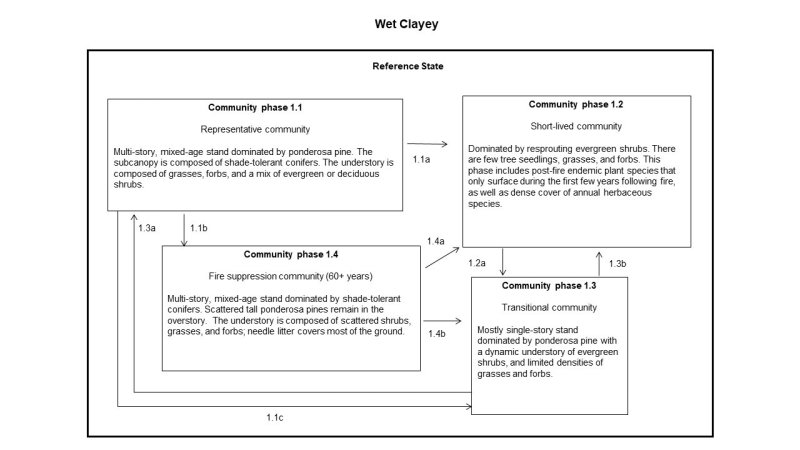Ecological site group F021XG913CA
Wet Clayey
Last updated: 08/16/2024
Accessed: 12/21/2025
Ecological site group description
Key Characteristics
None specified
Provisional. A provisional ecological site description has undergone quality control and quality assurance review. It contains a working state and transition model and enough information to identify the ecological site.
Physiography
Winterim soils are on plateaus. Slopes are 0 to 60 percent. Elevations are 1,480 to 2,000 meters.
Soil features
This ESG is primarily on Winterim soils in MLRA 21. Winterim soils are clayey-skeletal, smectitic, frigid Pachic Argixerolls. Winterim series characteristics include:
Soil moisture: Typically moist in winter and spring; dry for 80 to 100 consecutive days following the summer solstice; xeric moisture regime.
Mean annual soil temperature: 7 to 8 degrees C.
Mollic epipedon thickness: 50 to 76 centimeters; includes the Bt1 and Bt2 horizons.
Depth to base of argillic horizon: 100 to 150 centimeters.
Depth to bedrock: 100 to 150 centimeters; lithology is weathered volcanic rock such as basalt.
Base saturation (sum of cations): 75 to 85 percent.
Reaction: Slightly acid or neutral.
Particle-size control section
Clay content: Averages 35 to 50 percent.
Rock fragments: Averages 35 to 60 percent, mainly gravel. Lithology of fragments is volcanic rocks such as basalt and tuff.
Vegetation dynamics
The ponderosa pine habitat includes pure stands of ponderosa pine as well as stands of mixed species in which at least 50 percent of the canopy area is ponderosa pine. Associated species vary depending on location in the state and site conditions. Associated tree species include white fir, incense cedar, Coulter pine, Jeffrey pine, sugar pine, Douglas-fir, bigcone Douglas-fir, canyon live oak, California black oak, Oregon white oak, western juniper, Pacific madrone, and tanoak. In northern California, ponderosa pine stands are below mixed conifer woodlands, and above coastal oak, valley oak, blue oak, and blue oak-foothill pine woodlands. Montane hardwood stands may be below or interspersed with ponderosa pine stands. Jeffrey pine stands are typically above ponderosa pine stands, but may be found on serpentine soils or on harsh sites at lower elevations in the ponderosa pine zone.
Associated shrubs include manzanita, ceanothus, mountain misery, Pacific dogwood, hairy yerba santa, yellowleaf silktassel, bitter cherry, California buckthorn, poison oak, and Sierra gooseberry. Grasses and forbs include slimleaf brome, Orcutt's brome, sedge, smallflower melicgrass, bluegrass, squirreltail, bedstraw, brackenfern, bush morning-glory, diamond clarkia, Child's blue eyed Mary, giant woollystar, splendid woodland-gilia, rainbow iris, whiskerbrush, grape soda lupine, summer lupine, purple nightshade, streptanthus ssp., goosefoot violet, and wild iris.
Most ponderosa pine stands that include other coniferous trees are likely maintained by periodic ground fires. In many of these stands, crown fires result in dense montane chaparral communities. Young, dense stands, as in plantations, exclude most undergrowth once trees attain a closed canopy. Prior to canopy closure, dense brush is typical. An herbaceous layer may develop on some sites.
On dry or low-quality sites, significant pine regeneration may depend on concurrent disturbance of chaparral, in conjunction with a plentiful pine seed crop and favorable weather. Thus, it may require 50 to 100 years for significant pine regeneration without intervention. Clearcuts with minimal brush control develop a dense stand of pole-size trees in 20 to 30 years, which is twice the time required when brush is completely removed. In young stands, dense brush is typical, and an herbaceous layer may develop on some sites. On drier sites, tendency decreases for succession toward shade-adapted species. Sites disturbed by fire or logging sometimes convert to dense montane chaparral or mixed chaparral. Moist chaparral areas tend to develop directly into mixed conifer stands. As young, dense stands age and attain a closed canopy, they exclude most undergrowth. When other adapted conifers are present in moist ponderosa pine stands of medium to high site quality, they may form a significant understory in about 20 years in the absence of fire. If allowed to continue, such succession may sufficiently change the structure and composition of the stand within 40 years to favor wildlife adapted to mixed conifer habitats. Most ponderosa pine stands that include other coniferous trees are likely maintained by periodic ground fires.
Information from:
California Wildlife Habitat Relationships System
California Department of Fish and Game
California Interagency Wildlife Task Group
By E. Lee Fitzhugh
Major Land Resource Area
MLRA 021X
Klamath and Shasta Valleys and Basins
Stage
Provisional
Click on box and path labels to scroll to the respective text.

